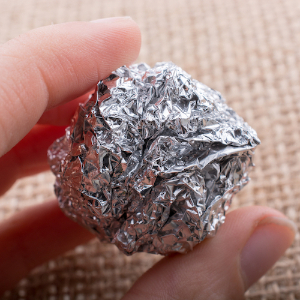Finally! A conclusive answer to the age-old question: “Shiny side or dull side out when roasting the turkey?” And other aluminum foil facts you might have wondered about. Not the least of which: Why is there a shiny side and a dull side, anyway?
What better time of year than the Holidays to address the home cook’s most frequently asked questions about aluminum foil? We’ll use more today than any other day of the year to cover our feast-table roasts while they cook…
The big question
… Is always whether to turn the shiny side in or out when you cover the roast. And Reynolds Alum-inum, one of the largest makers of kitchen foil in the world, has the definitive answer: Would you be surprised to know that it makes no difference? Your food won’t cook any faster or any slower, or come out any browner or crispier depending on which side of the foil is up.
I grew up with a gospel edict from Mom and Grandma that you have to layer the shiny side up so the roast doesn’t cook too fast and burn on the outside before the inside is cooked through. “The shiny side reflects some of the heat away,” Mom explained.
Reynolds says that’s simply not true. And that opinion jives with some aluminum facts they imparted to us at culinary school. When considering which kind of pots and pans you should cook with, you need to take into account which metal conducts heat best. I initially thought that was cast copper. But it turns out aluminum is a better heat conductor than copper, cast iron or steel.
That means aluminum heats up faster, and may get hotter at the same burner or oven setting than copper iron or steel.
So why do we uncover the roast half an hour before it’s done to make sure it gets nice and brown and crispy on top? The foil keeps moisture from escaping the pan, so the roast will poach rather than brown if you leave the foil on.
Why two different sides?
Food scientist Lara Tiro explains… “The final stage of the [foil making] process is called cold-rolling, which includes passing two layers of foil through sets of rollers simultaneously. This further reduces the desired thickness and improves the material’s final resistance and flexibility.”
And she says it’s just a coincidence – an artifact of the process – that, “the foil comes out shiny on the side that is in contact with the polished steel rollers, and dull on the side that is not in contact with the rollers.”
I always thought they took great pains to produce foil with one side shiny and the other dull. For important reasons. Another myth shattered. Another culinary loss of innocence…
My take
Yes, I was shocked by some of the things I learned today about aluminum foil. But these revelations are not going to change the way I use the stuff in my kitchen. My way works just fine for me, and I’m just going to keep on doing what I’ve been doing.
Stubborn? Illogical? Unreasonable? Maybe. But some friends and associates will tell you that’s just the way I approach life in general…
Cheers!
~ Maggie J.


